Overlapping against a low defensive block and in counter attacking
This session focuses on attacking play and, in particular, the use of overlaps to create and exploit space, a fundamental principle of attacking football. Ultimately, a team can go through, round or over the opposition’s defence in the process of scoring or making an attempt on goal.

| Area | Full pitch |
| Equipment | Balls, cones, goals, mannequins |
| No. of Players | Up to 10v10 plus keeper |
| Session Time | 80mins |
This session focuses on attacking play and, in particular, the use of overlaps to create and exploit space, a fundamental principle of attacking football. Ultimately, a team can go through, round or over the opposition’s defence in the process of scoring or making an attempt on goal.
Some teams will use a multi-faceted approach to attacking, while others are more one-dimensional, but each must be prepared for. The way the opposition defends will impact how space can be exploited (by using high, medium or low block... or a combination), and whether space can be found to the sides or behind. The use of overlapping is a highly effective manoeuvre in attacking play, and is a tactic we often deploy at Real Madrid.
What do I get the players to do?
Technical expertise (12mins)
Following a standard warm-up (8mins), we set up as shown (1) - a simple ‘pass and follow’ process in a passing circuit, with one-two combination play in wide positions. We want to see movement before the ball is received, good timing and weight of the pass, and playing intensity.
1
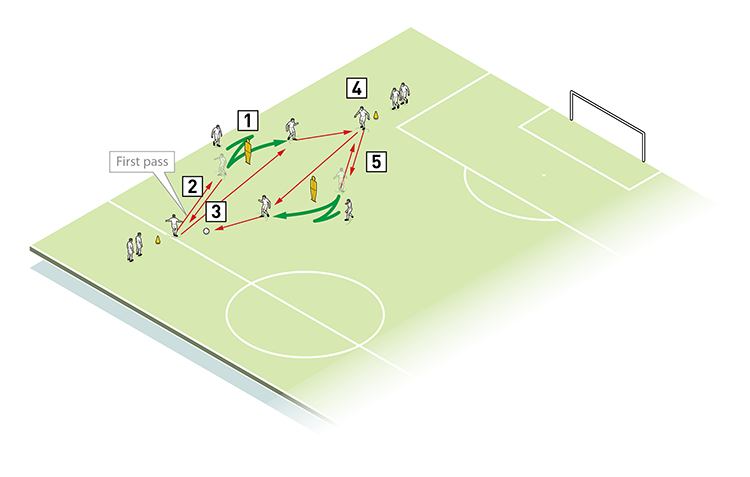
2. An initial one-two is made
3. A longer pass is set on the other side of the mannequin
4. The sequence makes it to the top
5. Now the move comes back the other way
In the second practice (2), we progress things so the wide player moves inside either with or without the ball. He then chooses to either pass to that overlapping player or go it alone.
2
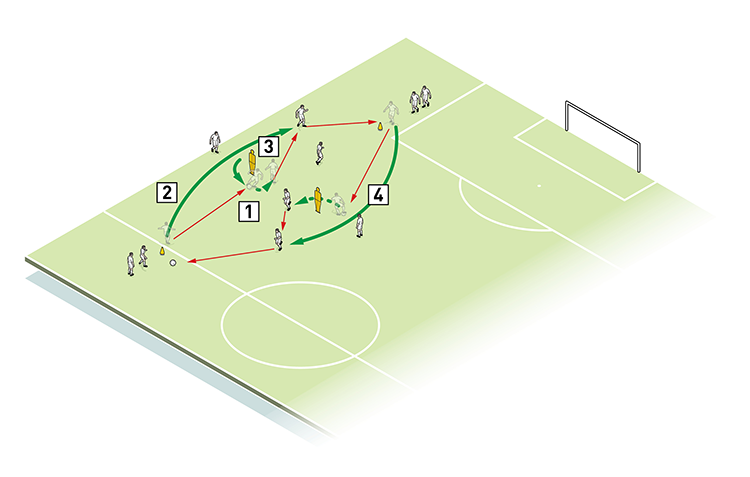
2. The serving player makes an overlapping run
3. The wide player turns and feeds a pass to the overlapping player
4. The wide player can choose to receive outside the mannequin, before turning inside and passing to the overlapping player
4v3 counter-attacking (15mins)
Now we move into the centre of the pitch to set up a practice where four attackers must advance in on three defenders at speed (3).
3
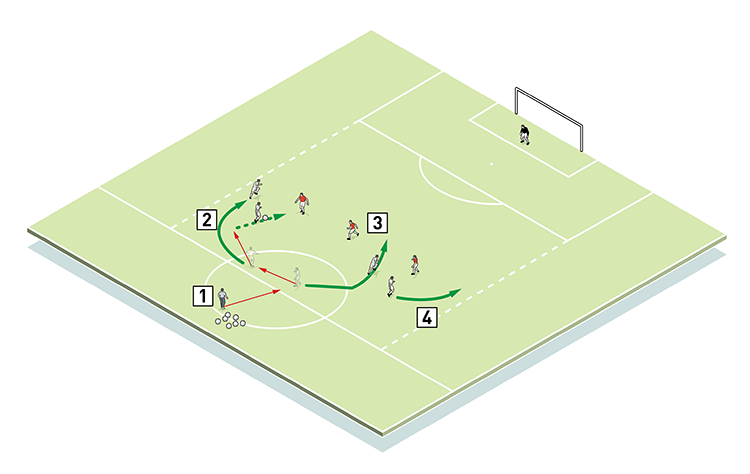
2. The use of a quick overlap after an initial pass is key
3. The central attacker looks for a space to exploit between defenders
4. The opposite full-back stays wide in order to be available for a switch
Attackers 1 and 2 attempt to isolate defender 1 in creating a 2v1 situation. Attacker 3 penetrates the defensive line by making a diagonal run between defenders 2 and 3. Attacker 4 maintains width on the right side.
Attackers know that to defend the overlap and diagonal run, defenders have to slide together, closing the space between. If they do this, the ball should be switched back quickly to the opposite side.
Phase of play (20mins)
This is 10v10 plus one keeper (4). Teams are organised in a low defensive block, with the attacking team aiming to create space by spreading out end to end and side to side - note the spacing between players and the positioning between the lines of the opposition.
4
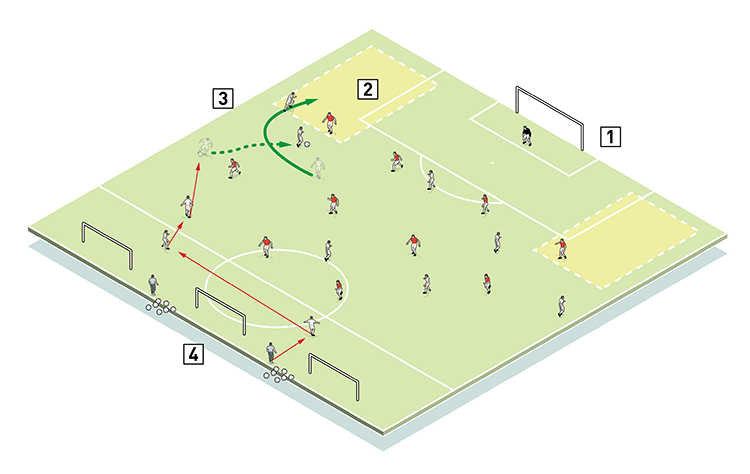
2. Green shaded areas represent key attacking spaces
3. Again, a wide overlap is essential for beating the block
4. Reds can counter with the aim of scoring in any of the three goals
The attacking team attempts to exploit the green shaded areas as this is where most space can be found. Should reds recover the ball, they attack any of the three small goals.
We are looking for good positioning, technical quality, quick ball movement and clever running off the ball, smart decision-making, switches of play, overlaps, crossing and finishing, and balance in order to prevent counter-attacks.
Game (20mins)
This is a conditioned game to encourage overlapping (5). The wide areas are marked off into zones where only one defender and two attackers can enter, while the pitch is divided into thirds with offsides ‘live’ from these lines. A goal scored that uses an overlapping movement counts double
5
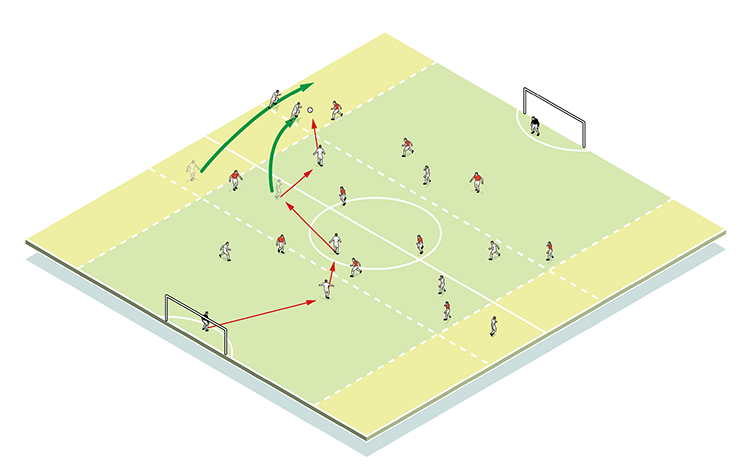
Editor's Picks
Attacking transitions
Deep runs in the final third
Using the goalkeeper in build-up play
Intensive boxes drill with goals
Penetrating the final third
Creating and finishing
My philosophy
Pressing initiation
Compact team movement
Coaches' Testimonials
Coaches' Testimonials
Join the world's leading coaches and managers and discover for yourself one of the best kept secrets in coaching. No other training tool on the planet is written or read by the calibre of names you’ll find in Elite Soccer.
In a recent survey 92% of subscribers said Elite Soccer makes them more confident, 89% said it makes them a more effective coach and 91% said it makes them more inspired.
Get Monthly Inspiration
All the latest techniques and approaches
Since 2010 Elite Soccer has given subscribers exclusive insight into the training ground practices of the world’s best coaches. Published in partnership with the League Managers Association we have unparalleled access to the leading lights in the English leagues, as well as a host of international managers.
Elite Soccer exclusively features sessions written by the coaches themselves. There are no observed sessions and no sessions “in the style of”, just first-hand advice delivered direct to you from the coach.























